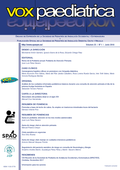![]()
Valoración antropométrica tras tratamiento con hormona de crecimiento en un grupo de niños nacidos pequeños para la edad gestacional
Antecedentes: El estudio de los niños pequeños para la edad gestacional (PEG) es de gran importancia al representar un grupo de riesgo para padecer enfermedades muy diversas. Diversos estudios han administrado hormona de crecimiento recombinante humana (rhGH) con resultados positivos en cuanto a talla, IMC, velocidad de crecimiento, índice edad ósea/edad cronológica (EO/EC).
Objetivos: Conocer la respuesta del crecimiento a la rhGH en niños PEG durante los tres primeros años de tratamiento, así como el índice de masa corporal, EO/EC y dosis de rhGH empleada.
Métodos: Muestra de 28 niños PEG atendidos en la Unidad de Endocrinología Pediátrica del Hospital Universitario de Valme, en los tres primeros años de recibir el tratamiento (Entre Enero 2012 y Diciembre de 2014).
Resultados: Se presentaron cambios significativos en la diferencia entre la talla y la talla diana pasando de -2,18 SDS a -0,41 SDS, así como en EO/EC y velocidad de crecimiento. La dosis de rhGH empleada y el IMC no mostraron cambios significativos.
Conclusiones: El tratamiento con rhGH en nuestra muestra mejora la talla en los niños PEG de manera significativa en los 3 primeros años de tratamiento.
Background: The study of children born small for gestational age is important due to represent a group at risk for very different diseases. Several studies have administered human recombinant growth hormone (rhGH) with positive results in size, BMI, growth rate, bone age / chronological age index.
Objectives: To know the growth response to rhGH in PEG children during the first three years of treatment, as well as body mass index, bone age/chronological age index and dose of rhGH used.
Methods: A sample of 28 children born small for gestational age, was seen at the Pediatric Endocrinology Unit of the Hospital Universitario de Valme in the first three years of treatment (between January 2012 and December 2014).
Results: There were significant changes in the difference between size and target size, from -2.18 SDS to -0.41 SDS, as well as in bone age/chronological age index and growth rate. The dose of rhGH used and the BMI did not show significant changes.
Disscusion: Treatment with rhGH in our sample improves size in PEG children significantly in the first 3 years of treatment.
| Adjunto | Tamaño |
|---|---|
| revista_2_de_2017_web.5.pdf | 500.91 KB |



